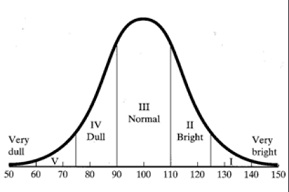Discuss the below:
Q: A. Assuming that the distribution of IQ is accurately represented by the bell curve below, determine the proportion of people with IQs in each of the five cognitive classes defined by Herrnstein and Murray.
The distribution of IQ

b. Although the cognitive classes above are defined in terms of percentiles, the authors stress the IQ scores should be compared with z-scores, not percentiles. In other words, it is more informative to give the difference in z-scores for two IQ scores than it is to give the difference in percentiles. To demonstrate this point, calculate the difference in z-scores for IQs at the 50th and 55th percentiles. Do the same for IQs at the 94th and 99th percentiles. What do you observe?
c. Researchers have found that scores on many intelligence tests are decidedly non-normal. Some distributions are skewed towards higher scores, other toward lower scores. How would the proportions in the five cognitive classes differ for an IQ distribution that is skewed right? Skewed left?